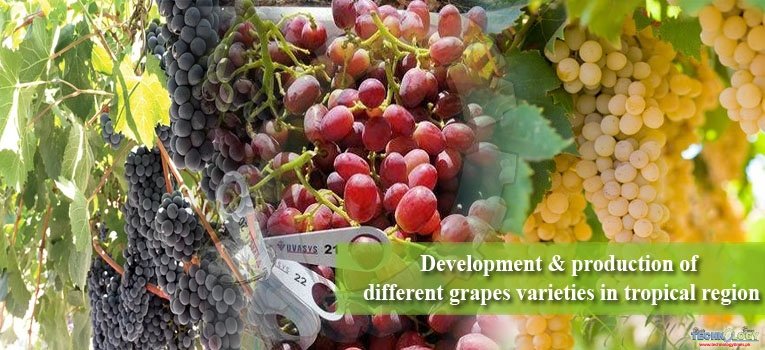In less than 50 years, grapes cultivation in tropics has changed from being somewhat of a horticultural curiosity, but it the most common temperate fruits growing in tropical regions.

At present, world production is more than 3 million tons per year, and India produces more than one million tons and Brazil produce grapes every year. Other tropical producers include Yemen 163,000, Peru 136,000, Thailand 40,000, Colombia 19,000, Tanzania 14,000 and Venezuela 11,500 tons. Many other tropical countries produce small amounts for local consumption, while grapes are produced in the tropical part of Saudi Arabia and Mexico.
There are many different climates in tropics due to changes in humidity, temperature, precipitation amount and altitude and distribution. The most suitable ones for growing green vines and producing grapes have a reliable dry period in which dry and maturing occurs over a minimum period of at least 3 months and with average minimum temperatures above 15 ° C.
In both dry and wet tropics, it can be manipulated to extend between 5 and 12 months with a combination of growth in the vine, planting cycle, pruning, unchanging vine water condition and logical use of chemical regulators. In tropical regions, overhead cage cages separating bundles from the vine canopy and reducing rotting decay are the most common vine type training.
Some elevated areas in tropical areas have cold periods that cause the leaves to fall, and in these regions the growth cycle of the vine plant is climate-controlled and cannot be manipulated. Initially grape vines were grown in tropical regions for the production of table grapes and these are still the main uses.
Thanks to the capacity to produce more than one product per year, the supply of large amounts of nutritious fresh fruit can be achieved in times when the supply of tropical fruits is limited. New developments in this area include the growing of a variety of seedless varieties and the selection and cultivation of new clones and varieties that are more suitable for the tropics.
Another innovation is the use of plastic shelters and plastic houses with open sides to protect vines from rain, reduce bunch rot, and change ripening times slightly. The adoption of post-harvest techniques originally developed for grapes from temperate regions is of great importance for tropical grapes.
These include fumigation of the grapes with gaseous and slowly released sulfur dioxide papers upon storage at temperatures above zero. These treatments greatly extend the shelf life of tropical grapes and allow them to be transported to remote markets. A relatively new development has been the use of tropical grapes for the production of both wine and raisins.
Shiraz and Chenin Blanc varieties are good wines producer in the slightly elevated, wet tropical areas of northern and eastern Thailand. The grapes of the larger crops matured in the low rainy months are of better quality and have less disease than the monsoon crops.
In a region with a somewhat similar climate, in South India’s Deccan Plateau, a number of wine making varieties are now grown and cropped once a year, with grapes being used only for wine production. Good wines are also made from grapes grown in semolina and cut twice a year, from grapes in the dry tropical regions of Venezuela Brazil. As with almost all wine grapes grown in warm regions, it is mandatory to supplement with tartaric acid to provide a suitable acid balance to the wine.
Raisin production in high humidity tropics is perhaps the biggest challenge for tropical grapes; however, in South Australia, this problem is largely solved by using paper developed in Australia to produce raisins instead of drying them on paper.
In this diagram, the Thomson Seedless (Sultana) grapes are dried on wire mesh shelves with roofs that protect them from rain, their emulsions of fatty acids (mostly ethyloleate) and the production of light brown raisins after treatment with potassium carbonate that accelerates the drying. It is clear that tropical grape production is now a major world industry and that grapes can be used for the production of fresh food, wine and raisins.
